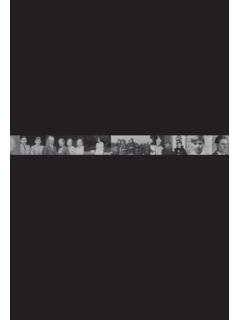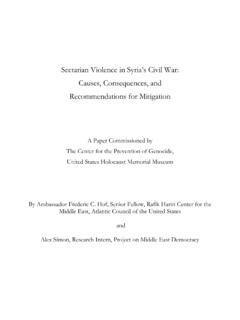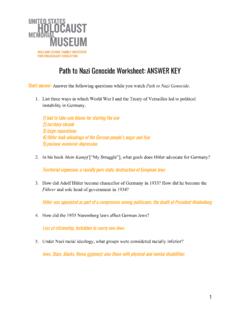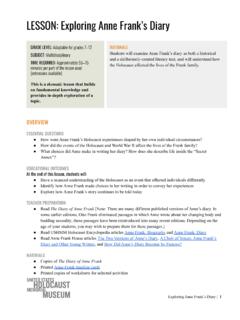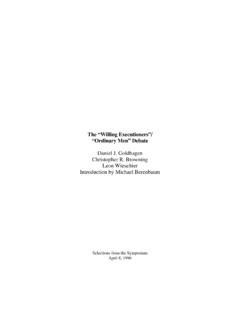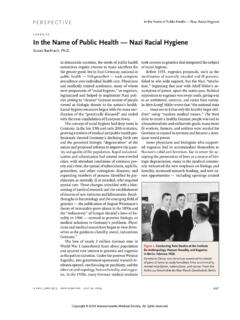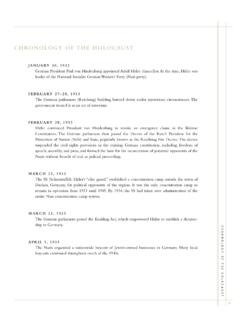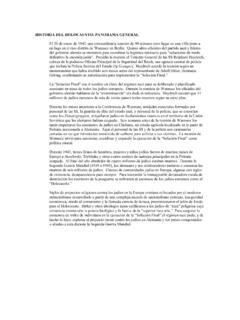Transcription of L ESSON : Understand i ng Nazi Symbols
1 LESSON: Understanding nazi SymbolsGRADE LEVEL:Adaptable for grades 7 12 SUBJECT:MultidisciplinaryTIME REQUIRED:Approximately 60 75minutes (extensions available)This is afoundationallesson thatintroduces key concepts andinformation to focusing on the history and meaning of the swastika, thelesson provides a model for teachers to use when examining theorigins of Symbols , terms, and ideology from nazi Germany andHolocaust-era fascist movements that students are seeing incontemporary American culture, promoting critical historicalthinking and lesson model can be utilized to encourage critical analysisof other Symbols included in thisGlossarythat highlightstheorigins of neo- nazi and white supremacist terms and :This lesson is not intended as a crisis responseto antisemitic acts oncampuses but rather an approach to understanding the historicalsignificance of nazi Symbols seen QUESTIONS Why are Symbols powerful and why do people use them?
2 Why is the history of a symbol important? How can we examine modern-day Symbols from a critical and informed viewpoint?EDUCATIONAL OUTCOMESAt the end of this lesson, students Understand : What makes a symbol appealing and effective How the meaning of a symbol can change over time How historical context informs the meaning of a symbol How flags, labels, and Symbols contribute to the rise of an ideology How the swastika is connected to nazi ideologyTEACHER PREPARATION Computers with internet access for seven groupsORprint articles for students Student interactive sheet ReadHolocaust Encyclopediaarticles: nazi Rule Nuremberg Race Laws nazi Terror Begins Victims of the nazi Era Understanding nazi Symbols |1 LESSON: Understanding nazi Symbols nazi Propaganda nazi Racism History of the Swastika LEARNER VARIABILITY MODIFICATIONS AND ACCOMMODATIONSThe lesson is intentionally flexible to allow for individual teacher modifications to achieve and teaching strategies are suggestedin the instructional sequence.
3 Please use other options ifthey support the learning needs of your students. Consider utilizing graphic organizers, note-taking strategies, readingchoices, and online engagement may choose to use learner variability modifications specific to this lesson: Teachers can provide students with choices as to how they access information throughout lessons, read print alone, read print with a partner, read along while the teacher reads aloud, etc. Define terms that would clarify understanding for students. Use online discussion or engagement tools that work best in your classroom, such as Padlet. Holocaust Encyclopediaarticles are available in variouslanguages; refer to the word Language and select the Globe icon available on the lefthand side of the article. Transcripts are provided for video and audio files. Reference theGlossaryin theHolocaust Encyclopediafor definitional support. Incorporate strategies such as think-pair-share and jigsaw to enhance student lesson is available as anonline, asynchronousexperience for students, which can be accessed througha webbrowser or LMS files.
4 The online lessons are accessible to all students for in-person and virtual learning, and theyprovide specific support for students using screen ONE: SYMBOLSDEFINING the crying while laughing emoji, or ask students to draw/share their favorite THE STUDENTS What does the emoji mean? How do you know this? Does it always mean the same thing? What are the possiblemultiple meanings? What makes an emoji appealing and effective? What impacts how you interpret emojis? Do emojis have the same meaning in different contexts? Does your spokenlanguage matter? Are the meanings of emojis universal?Understanding nazi Symbols |2 LESSON: Understanding nazi Symbols Aword cloudor padlet can be used to show : We all use Symbols They are all around us Different people can interpret the same symbol in different emojis and Symbols : Emojisare a small digitalsymbolused to expressan idea, emotion, have a variety of meanings:SUMMARY OF FAITH/DOCTRINEStar of David = Jewish faithSTANDS FOR ORSUGGESTS SOMETHING ELSE= WiFiA VISIBLE SIGN OFSOMETHING INVISIBLE lion = courageOBJECT WITHCULTURAL SIGNIFICANCE bald eagle = America; the different definitions of Symbols .
5 Which definition would cover the Americanflag? The peace sign? A commercial logo? Ask students to name four Symbols and analyzewhat type of symbol it is by placing it on the chart on theirstudent interactive do people use Symbols ? What makes Symbols appealing? Effective? Why are symbolsso powerful? : Symbols help people Understand their world and convey information Symbols represent ideologies: a system of ideas and ideals, especially one which formsthe basis of economic or political theory and policy Symbols can also represent what considering how Symbols are used, analyze how Symbols can represent beliefs. Whatare beliefs? How are they different from facts and opinions? Share these definitions: Afactis verifiable. We can determine whether itis true by researching the evidence. Anopinionis a judgment based on facts, an honestattempt to draw a reasonableconclusion from factual nazi Symbols |3 LESSON: Understanding nazi Symbols Unlike an opinion, abeliefis a conviction based on cultural or personal faith, morality, do Symbols represent facts, opinions, or beliefs?
6 What are some of the beliefsrepresented in the Symbols already discussed? Record do Symbols represent membership in a particular group? Do you belong to groups withsymbols?PART TWO: HISTORY OF THE clipof nazi defeat and swastika beingdestroyed. Who destroyed the swastika inthe clip? Why? Have you seen swastikas before? of the swastika: teacher presentskey facts The swastika was long used as a symbol of well-being in ancient societies, includingthose in India, China, Africa, America, and Europe. To this day, the swastika is a sacredsymbol in Hinduism, Buddhism, Jainism, and Odinism. Adolf Hitler designed the nazi flag in 1920. He combined the swastika with the threecolors of the German Imperial flag (red, black, and white). As a symbol, it became associated with the idea of a racially pure state. By the time theNazis gained control of Germany, the connotations of the swastika had forever changed. nazi Symbols , including the swastika flag, are banned in a number of countries today,including in groups (jigsaw activity), students readUSHMM Holocaust Encyclopedia articlesonThe Holocaust: A Learning Site for Studentsandanswer questions below (on theStudentinteractive sheet).
7 Students can also generate theirown questions. Group one: nazi Rule Group two: The Nuremberg Race Laws Group three: nazi Terror Begins Group four: Prisoners of the Camps Group five: nazi Propaganda Group six: nazi Racism Group seven: History of the Swastika Questions The swastika was the official symbol of nazi Germany, representative of nazi were some nazi ideas about government, society, and law? What rights did nazi officials revoke during the Third Reich?Understanding nazi Symbols |4 LESSON: Understanding nazi Symbols How is the swastika connected to nazi ideas and beliefs? Can it be separated from Naziideas? Explain answers with evidence from the articles. How does learning this historical context change how you view swastikas?After time to read and record, students report back to the class. This can be interactive usingpadlet or google classroom, or chart with the class: The swastika was the official symbol of nazi Germany, representativeof nazi ideas.
8 What did nazi Germany stand for? Refer back to the chart with the definitionof Symbols to frame this list that defines the swastika. Consider: How does it stand for something else? How is the swastika a summary of a doctrine? What is the swastika a visible sign of? In light of its history, what is its cultural significance of the swastika? audio clip:Helen GoldkindTranscript for Helen Goldkind clipInterviewer: You were talking about what sights or sounds or smells trigger yourmemories of the war and when you see a chimney that brings back else?Helen: You know , it just depends, it just depends. A swastika. You know , when Isee a swastika I feel I m in danger. Its it sounds crazy to other people becauseother people are not affected at all by a swastika. That swastika cannot hurt what [it] represents to me is something with Helen Goldkind, February 21, as a class How does seeing a swastika today impact Helen Goldkind, a Holocaust survivor?
9 Given this quotation from a Holocaust survivor, what are the possible consequences ofdisplaying this symbol today? How might displaying this symbol impact people whoview it? the Talkis one option. Why are Symbols so powerful and why do people use them? How has the meaning of the swastika changed throughout history ?Understanding nazi Symbols |5 LESSON: Understanding nazi SymbolsCONCLUSIONASSESSMENTIn addition to the concluding writing assignment to construct an argument to support answers tothe essential questions, student interactive sheets, group work, and class participation can beevaluated for understanding. See additional resources A literary symbol is an object, a person, a situation, or an action that has a literal meaningin a story but suggests or represents other meanings. Choose a recent book your studentsread and studied in class. Have students brainstorm three Symbols they found, and havethem create a visual representation that reflects the literal meaning and the suggestedmeaning.
10 Students examine newspaper articles from the 1940s and today to explore how differentcommunities have reacted to the display of swastikas: RESOURCES Summaryof Helen Goldkind audio clip Helen Goldkind biography Frank Meenik podcast USHMM Teaching about Propaganda(includes analysistools) Origins of Neo- nazi White Supremacist Terms and Symbols Fred Taucher Testimony On Being episode: The unlikely friendship that blossomedbetween Derek Black, the former white-powerheir apparent, and Matthew Stevenson, an Orthodox Jew, after Stevenson invited Black to Shabbat nazi Symbols |6
